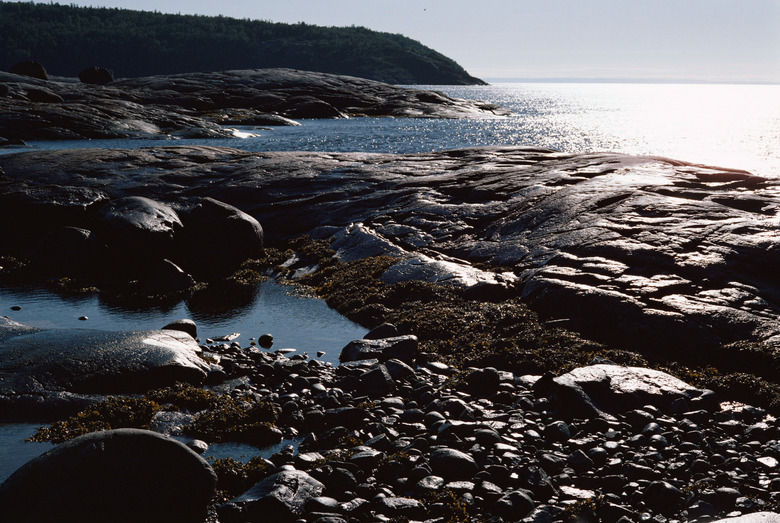Examples Of Tide Pool Predators
The tide washes out to sea, leaving the ocean's life-giving water amid the sand, pebbles and rocks on the shore. In those tide pools, a variety of life abounds, from mussels to crabs to tiny fish. While the tide pool habitat provides shelter to small sea creatures, it's also the hunting ground for a number of predators.
Mammals
Mammals
Land mammals, including humans (Homo sapiens), raccoons (Procyon lotor) and river otters (Lontra canadensis) prey on crabs, fish and shellfish found in tide pools. Sea otters (Enhydra lutris) also scramble among the tide pools to find abalone (Haliotis spp.) and other tide pool and kelp bed dwellers, such as coast mussels (Mytilus edulis), sea urchins (Strongylocentrotus spp.) and sea stars (Pisaster ochraceus).
Birds
Birds
A visit to tide pools finds a variety of seabirds and shorebirds plucking their prey from the tide pools. The ever-present California, herring and other sea gull species (Larus spp.) scavenge along the shoreline for dead fish and pry mussels (Mytilus spp.) off the rocks in and around the tide pools. Meanwhile, great blue herons (Ardea herodias) and snowy egrets (Egretta thula) stalk the fish hiding among the rocks in tide pools.
Fish
Fish
And when they are not themselves being predated on, fish such as juvenile opaleye perch (Girella nigricans), northern clingfish (Gobiesox maeandricus) and tide pool sculpins (Oligocottus spp.) prey upon the other inhabitants of the tide pool, including small crabs and other crustaceans, shrimp, worms and other fish. They're also cannibals, catching and eating other fish of the same species. While young opaleye perch are carnivorous, when mature these fish are vegetarians and eat only algae.
Invertebrates
Invertebrates
Tide pools shelter many invertebrates, or animals without backbones. While some eat only vegetable matter, others such as crabs (order Decapoda), octopi (class Cephalopoda), sea anemone (class Anthozoa) and starfish (class Asteroidea). There are hundreds of members in each class of invertebrates, and many are carnivores, eating the other small creatures that also inhabit tide pools. Starfish, which feed mainly on shellfish, are rarely eaten by other predators. In fact, if a starfish loses an arm to a shark or sea otter, it can grow a replacement.
References
- Animal Diversity Web: Homo Sapiens — Human
- Sea World: Tide Pools — Intertidal Marine Vertebrates
- Cornell Lab of Ornithology: All About Birds — California Gull
- Laguna Ocean Foundation: Tidepool Ecology & Common Organisms
- Sea World: Tide Pools — Intertidal Marine Invertebrates
- Marine Science: The Mid Tide Zone
Cite This Article
MLA
Jauregui, Ruth de. "Examples Of Tide Pool Predators" sciencing.com, https://www.sciencing.com/examples-tide-pool-predators-7711/. 24 April 2017.
APA
Jauregui, Ruth de. (2017, April 24). Examples Of Tide Pool Predators. sciencing.com. Retrieved from https://www.sciencing.com/examples-tide-pool-predators-7711/
Chicago
Jauregui, Ruth de. Examples Of Tide Pool Predators last modified March 24, 2022. https://www.sciencing.com/examples-tide-pool-predators-7711/
